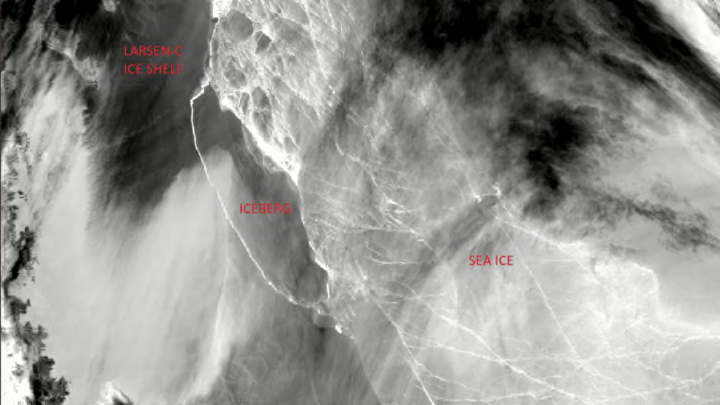Well, it finally happened. As Mental Floss reported last week, the last few decades have seen dramatic changes to the Larsen ice shelf, most recently with a growing rift along the section called Larsen C threatening to entirely break off. This week, it finally split, creating an iceberg the size of Delaware. At more than a trillion tons, it's one of the largest icebergs ever recorded.
The sections called Larsen A and B collapsed in 1995 and 2002, respectively, effectively reshaping the coastline of the Antarctic Peninsula.
The Larsen C crack spread slowly—you might say glacially—at first. But by June 2017, it was cruising right along, widening at a pace of about 32 feet per day. Experts at Swansea University’s Project Midas, which monitors the ice shelf, predicted the break would come within "hours, days, or weeks."
It took about a week. New imagery from NASA’s Suomi National Polar-orbiting Partnership (NPP) satellite shows a distinct split in the ice shelf.
A view of the newly-formed #larsenc iceberg in #Antarctica, taken at 03:00 UTC this morning by the @NASANPP satellite. pic.twitter.com/nn7j2uGFMU
— Simon Proud (@simon_sat) July 12, 2017
"The rift was barely visible in these data in recent weeks," Adrian Luckman of Swansea University told the BBC, "but the signature is so clear now that it must have opened considerably along its whole length."
The precise cause of the split remains to be seen. While climate change is responsible for melting sea ice around the world, experts say this particular break may have been inevitable.
"We know that rifts like this periodically propagate and cause large tabular icebergs to break from ice shelves, even in the absence of any climate-driven changes," Chris Borstad, of the University Centre in Svalbard, told the BBC. "I am working with a number of colleagues to design field experiments on Larsen C to answer this specific question (by measuring the properties of the Joerg suture zone directly). But until we get down there and take some more measurements, we can only speculate."
[h/t BBC]
